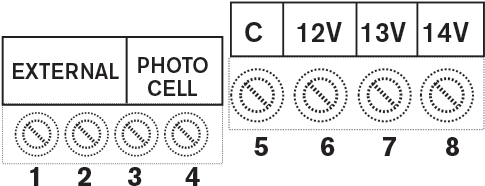TRANSFORMER TERMINAL BLOCK
The LX Series Transformer includes one “common” lug, and three “hot” lugs. Four smaller lugs are located on left side of the voltage lugs, which provide a connection for an External Transformer Signal of 12-24 volts and two connections for the proprietary low voltage Photocell unit.
COMMON LUGS
One conductor from each cable run coming from the lights to the transformer must be connected to one of the common lugs. The other conductor will be installed into the hot lug that provides the optimum voltage for each circuit.

CHOOSING THE PROPER “HOT” VOLTAGE LUG
Choosing the proper “hot” voltage lug in which to install the conductor is determined by the circuit’s voltage drop. If a circuit’s voltage drop is calculated to be about 3 volts, install the “hot” side of the cable into the 14 volt tap to assure proper voltage at the lamp (14 volts minus 3 volts = 11 volts). The voltage reading at each “hot” lug will vary depending upon the incoming voltage provided by the 120 volt receptacle. If the receptacle reads 128 volts, it is not uncommon for the 12 volt lug on the transformer to read 12.6–12.9 volts. On the other hand, if the receptacle is reading only 116 volts, the 12 volt lug may only read 11.8–12.2 volts. Always verify both high voltage and low voltage readings with a digital voltmeter. Fine-tune each circuit by using a digital voltmeter. Lamps perform best when supplied between 10.5 and 11.5 volts. Before waterproofing wire connections, take a voltage reading at the first and last fixture on each circuit. If the voltage reading at the first fixture on the circuit reads less than 10.5 volts, move the conductor up to a lug that will provide approximately 11 to 11.5 volts. LED fixtures should be provided between 10 and 15 volts.

